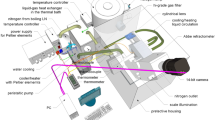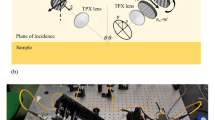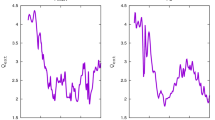Abstract
T. P. MURRAY1 described the measurement by ellipsometry of the thickness of oil films present on commercial tinplate. In his arrangement the elliptically polarized light reflected from the specimen surface was brought into a plane by means of a quarter-wave plate and the extinction position of the analyser found. After de-oiling the specimen a new extinction position was found by adjustment of the analyser only, the difference being proportional to oil film thickness. Angular shifts of a few tenths of a degree are common whereas the light intensity varies only slowly for several degrees about the minimum. Murray overcame this difficulty by reading the analyser for equal photoelectric responses either side of the minimum, but it occurred to me that a more elegant technique, leading to an easier to construct and possibly more accurate instrument, would be to use Faraday cells as described by E. J. Gillham2 for an automatic polarimeter.
This is a preview of subscription content, access via your institution
Access options
Subscribe to this journal
Receive 51 print issues and online access
$199.00 per year
only $3.90 per issue
Buy this article
- Purchase on Springer Link
- Instant access to full article PDF
Prices may be subject to local taxes which are calculated during checkout
Similar content being viewed by others
References
Murray, T. P., Rev. Sci. Inst., 33, 2, 172 (1962).
Gillham, E. J., Nature, 178, 1412 (1956).
Author information
Authors and Affiliations
Rights and permissions
About this article
Cite this article
RICHARD, M. Faraday Effect Ellipsometer. Nature 200, 768–769 (1963). https://doi.org/10.1038/200768a0
Issue Date:
DOI: https://doi.org/10.1038/200768a0
Comments
By submitting a comment you agree to abide by our Terms and Community Guidelines. If you find something abusive or that does not comply with our terms or guidelines please flag it as inappropriate.



